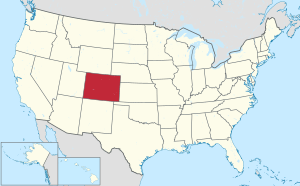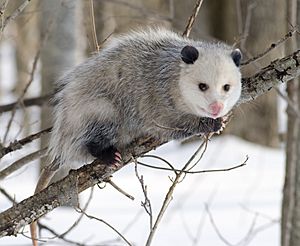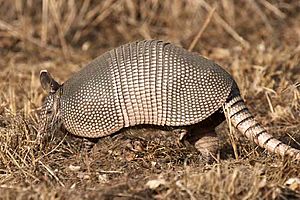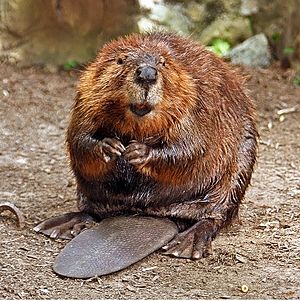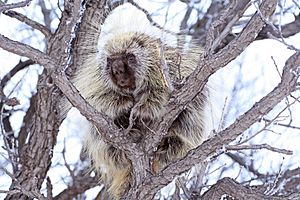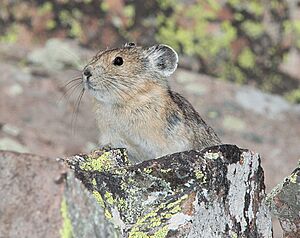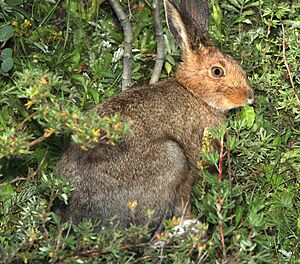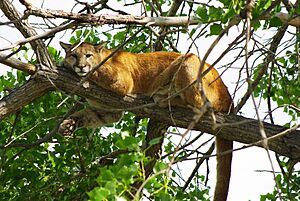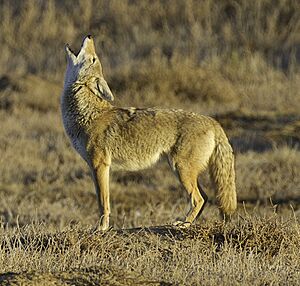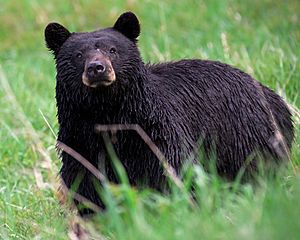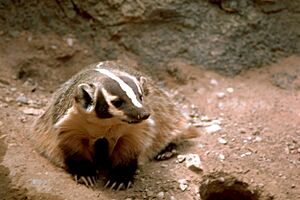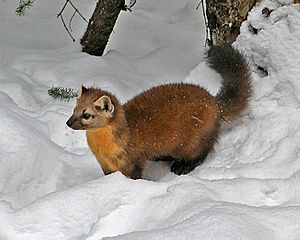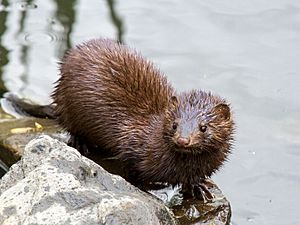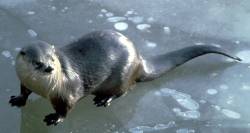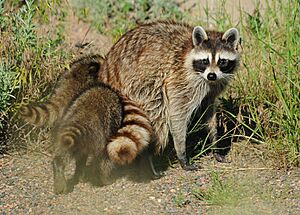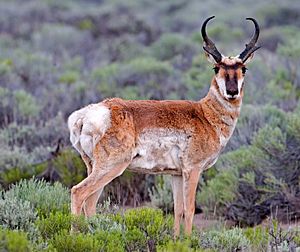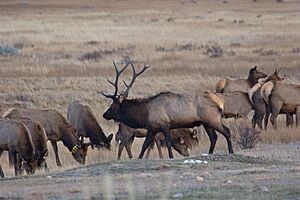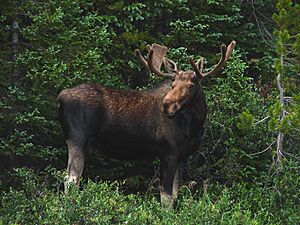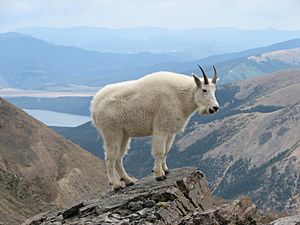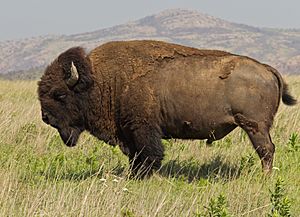List of mammals of Colorado facts for kids
Welcome to the exciting world of Colorado's wild mammals! This list shows all the amazing furry creatures that live freely in the state of Colorado. It's based on information from Colorado Parks and Wildlife. You won't find animals kept in zoos or as pets here, only those living in their natural homes.
We've grouped these animals to make them easier to understand. First, they are sorted into big groups called orders. Think of an order as a large family tree branch. Then, within each order, they are divided into smaller groups called families. Each animal's common name is listed, followed by its scientific name, which is like its unique secret code name.
Sometimes, you'll see special letters next to an animal's name:
- EN - This means the animal is endangered. It's in danger of disappearing forever, and we need to protect it!
- NT - This means the animal is near threatened. It's not in immediate danger, but its numbers are getting low, so we need to watch out for it.
Contents
Amazing Mammals of Colorado
Opossums and Their Relatives
Opossums are unique mammals. They are the only marsupials found in North America. This means they carry their babies in a pouch, just like kangaroos!
Opossums
Order: Didelphimorphia Family: Didelphidae
- Virginia opossum, Didelphis virginiana
Armored Mammals: Armadillos
Armadillos are famous for their tough, bony shells. They look like little tanks! They use their strong claws to dig for food and burrows.
Armadillos
Order: Cingulata Family: Dasypodidae
- Nine-banded armadillo, Dasypus novemcinctus
Rodents: Gnawing Wonders
Rodents are the largest group of mammals. They are known for their strong, ever-growing front teeth. These teeth help them gnaw on plants, nuts, and other foods.
Beavers
Beavers are amazing engineers. They build dams and lodges using trees and mud. They are the largest rodents in North America. Order: Rodentia Family: Castoridae
- North American beaver, Castor canadensis
Pocket Gophers
Pocket gophers are expert diggers. They have special fur-lined pockets on their cheeks. They use these pockets to carry food back to their underground homes. Order: Rodentia Family: Geomyidae
- Yellow-faced pocket gopher, Cratogeomys castanops
- Plains pocket gopher, Geomys bursarius
- Botta's pocket gopher, Thomomys bottae
- Northern pocket gopher, Thomomys talpoides
Kangaroo Rats and Pocket Mice
These small rodents are known for their large cheek pouches. They also have long tails and often hop like kangaroos. They are very good at living in dry areas. Order: Rodentia Family: Heteromyidae
- Hispid pocket mouse, Chaetodipus hispidus
- Ord's kangaroo rat, Dipodomys ordii
- Olive-backed pocket mouse, Perognathus fasciatus
- Plains pocket mouse, Perognathus flavescens
- Silky pocket mouse, Perognathus flavus
- Great Basin pocket mouse, Perognathus merriami
Porcupines
Porcupines are famous for their sharp quills. These quills are a defense mechanism. They protect the porcupine from predators. Order: Rodentia Family: Erethizontidae
- North American porcupine, Erethizon dorsatum
Jumping Mice
Jumping mice have very long tails and large hind feet. They use these features to make impressive leaps. They can jump to escape danger. Order: Rodentia Family: Dipodidae
- Meadow jumping mouse, Zapus hudsonius
- Western jumping mouse, Zapus princeps
New World Rats, Mice, and Voles
This is a very diverse group of rodents. It includes many different types of mice, rats, and voles. They live in various habitats across Colorado. Order: Rodentia Family: Cricetidae
- Sagebrush vole, Lemmiscus curtatus
- Long-tailed vole, Microtus longicaudus
- Mexican vole, Microtus mexicanus
- Montane vole, Microtus montanus
- Prairie vole, Microtus ochrogaster
- Meadow vole, Microtus pennsylvanicus
- Southern red-backed vole, Myodes gapperii
- White-throated woodrat, Neotoma albigula
- Bushy-tailed woodrat, Neotoma cinerea
- Eastern woodrat, Neotoma floridana
- Desert woodrat, Neotoma lepida
- Mexican woodrat, Neotoma mexicana
- Southern plains woodrat, Neotoma micropus
- Muskrat, Ondatra zibethicus
- Northern grasshopper mouse, Onychomys leucogaster
- Brush mouse, Peromyscus boylii
- Canyon mouse, Peromyscus crinitus
- White-footed mouse, Peromyscus leucopus
- Northern rock mouse, Peromyscus nasutus
- Western deer mouse, Peromyscus sonoriensis
- Pinyon mouse, Peromyscus truei
- Western heather vole, Phenacomys intermedius
- Western harvest mouse, Reithrodontomys megalotis
- Plains harvest mouse, Reithrodontomys montanus
- Hispid cotton rat, Sigmodon hispidus
Chipmunks, Marmots, and Squirrels
This group includes many familiar and active rodents. They are often seen scampering through trees or across the ground. They are known for collecting and storing food. Order: Rodentia Family: Sciuridae
- White-tailed antelope squirrel, Ammospermophilus leucurus
- Golden-mantled ground squirrel, Callospermophilus lateralis
- Gunnison's prairie dog, Cynomys gunnisoni
- White-tailed prairie dog, Cynomys leucurus
- Black-tailed prairie dog, Cynomys ludovicianus
- Northern flying squirrel, Glaucomys sabrinus
- Thirteen-lined ground squirrel, Ictodomys tridecemlineatus
- Yellow-bellied marmot, Marmota flaviventris
- Cliff chipmunk, Neotamias dorsalis
- Least chipmunk, Neotamias minimus
- Colorado chipmunk, Neotamias quadrivittatus
- Hopi chipmunk, Neotamias rufus
- Uinta chipmunk, Neotamias umbrinus
- Rock squirrel, Otospermophilus variegatus
- Abert's squirrel, Sciurus aberti
- Fox squirrel, Sciurus niger
- Southwestern red squirrel, Tamiasciurus fremonti
- American red squirrel, Tamiasciurus hudsonicus
- Wyoming ground squirrel, Urocitellus elegans
- Spotted ground squirrel, Xerospermophilus spilosoma
Lagomorphs: Hoppers and Nibblers
Lagomorphs include rabbits, hares, and pikas. They look a bit like rodents but have two sets of upper incisor teeth. They are herbivores, meaning they eat plants.
Pikas
Pikas are small, cute mammals that live in rocky mountain areas. They are known for collecting plants and drying them. This creates "haypiles" for winter food. Order: Lagomorpha Family: Ochotonidae
- American pika, Ochotona princeps
Hares and Rabbits
Hares and rabbits are well-known for their long ears and powerful hind legs. They use these legs to run fast and escape predators. Order: Lagomorpha Family: Leporidae
- Pygmy rabbit, Brachylagus idahodensis
- Snowshoe hare, Lepus americanus
- Black-tailed jackrabbit, Lepus californicus
- White-tailed jackrabbit, Lepus townsendii
- Desert cottontail, Sylvilagus audubonii
- Eastern cottontail, Sylvilagus floridanus
- Mountain cottontail, Sylvilagus nuttallii
Eulipotyphla: Shrews and Moles
This group includes small, insect-eating mammals. They have long snouts and tiny eyes. They are often found underground or in dense vegetation.
Shrews
Shrews are tiny, mouse-like mammals with long, pointed snouts. They have very high metabolisms. This means they need to eat almost constantly to stay alive. Order: Eulipotyphla Family: Soricidae
- Elliot's short-tailed shrew, Blarina hylophaga
- North American least shrew, Cryptotis parva
- Crawford's gray shrew, Notiosorex crawfordi
- Cinereus shrew, Sorex cinereus
- American pygmy shrew, Sorex hoyi
- Merriam's shrew, Sorex merriami
- Montane shrew, Sorex monticolus
- Dwarf shrew, Sorex nanus
- American water shrew, Sorex palustris
Moles
Moles are incredible diggers. They have powerful front paws and live mostly underground. They create complex tunnel systems to find worms and insects. Order: Eulipotyphla Family: Talpidae
- Eastern mole, Scalopus aquaticus
Chiroptera: Flying Mammals (Bats!)
Bats are the only mammals that can truly fly. Their wings are made of skin stretched between their elongated fingers and body. They use echolocation to navigate and find food in the dark.
Vesper Bats
Vesper bats are the most common type of bat. They are found all over the world. Many species live in Colorado, hunting insects at night. Order: Chiroptera Family: Vespertilionidae
- Silver-haired bat, Lasionycteris noctivagans
- California myotis, Myotis californicus
- Western small-footed myotis, Myotis ciliolabrum
- Long-eared myotis, Myotis evotis
- Little brown bat, Myotis lucifugus
- Fringed myotis, Myotis thysanodes
- Long-legged myotis, Myotis volans
- Yuma myotis, Myotis yumanensis
- Pallid bat, Antrozous pallidus
- Big brown bat, Eptesicus fuscus
- Spotted bat, Euderma maculatum
- Eastern red bat, Lasiurus borealis
- Hoary bat, Lasiurus cinereus
- Western pipistrelle, Parastrellus hesperus
- Tricolored bat, Perimyotis subflavus
- Townsend's big-eared bat, Corynorhinus townsendii
Free-tailed Bats
Free-tailed bats have a tail that extends beyond the edge of their tail membrane. This gives them their name. They are fast flyers and often live in large colonies. Order: Chiroptera Family: Molossidae
- Big free-tailed bat, Nyctinomops macrotis
- Mexican free-tailed bat, Tadarida brasiliensis
Carnivores: Hunters of Colorado
Carnivores are mammals that primarily eat meat. They have sharp teeth and claws. These help them catch and eat their prey.
Cats
Wild cats are powerful and stealthy hunters. They have excellent senses. They use these to stalk and ambush their prey. Order: Carnivora Family: Felidae
- Canada lynx, Lynx canadensis - This animal was brought back to Colorado after disappearing.
- Bobcat, Lynx rufus
- Cougar, Puma concolor
Canids: Dogs, Wolves, and Foxes
Canids are known for their strong sense of smell and their ability to run. They often hunt in packs or pairs. This helps them catch larger animals. Order: Carnivora Family: Canidae
- Coyote, Canis latrans
- Gray wolf, Canis lupus - Wolves have been brought back to Colorado.
- Northwestern wolf, C. l. occidentalis
- Great Plains wolf, C. l. nubilus
- Southern Rocky Mountain wolf, C. l. youngi
- Gray fox, Urocyon cinereoargenteus
- Kit fox, Vulpes macrotis
- Swift fox, Vulpes velox
- Red fox, Vulpes vulpes
Bears
Bears are large, powerful mammals. They are omnivores, meaning they eat both plants and meat. They are known for their strength and intelligence. Order: Carnivora Family: Ursidae
- American black bear, Ursus americanus
- Brown bear, Ursus arctos - This bear no longer lives in Colorado.
- Grizzly bear, U. a. horribilis - This specific type of brown bear no longer lives in Colorado.
Skunks
Skunks are famous for their strong-smelling spray. They use this spray to defend themselves. It's a powerful warning to predators. Order: Carnivora Family: Mephitidae
- American hog-nosed skunk, Conepatus leuconotus
- Striped skunk, Mephitis mephitis
- Western spotted skunk, Spilogale gracilis
- Eastern spotted skunk, Spilogale putorius
Weasels and Their Relatives
This family includes many agile and fierce predators. They have long, slender bodies. This helps them hunt in small spaces. Order: Carnivora Family: Mustelidae
- Wolverine, Gulo gulo - This animal no longer lives in Colorado.
- North American river otter, Lontra canadensis
- Pacific marten, Martes caurina
- Black-footed ferret, Mustela nigripes - This animal was brought back to Colorado.
- American ermine, Mustela richardsonii
- Long-tailed weasel, Neogale frenata
- American mink, Neogale vison
- American badger, Taxidea taxus
Procyonids: Raccoons and Ringtails
These mammals are known for their cleverness and adaptability. They often have distinctive facial markings. They can live in many different environments. Order: Carnivora Family: Procyonidae
Artiodactyla: Hoofed Mammals
Artiodactyls are hoofed mammals. They have an even number of toes on each foot. This group includes deer, elk, bison, and bighorn sheep.
Pronghorns
Pronghorns are incredibly fast runners. They are the fastest land animals in North America. They can reach speeds of up to 60 miles per hour! Order: Artiodactyla Family: Antilocapridae
- Pronghorn, Antilocapra americana
Deer Family
The deer family includes animals with antlers. Antlers are bony growths that usually grow and fall off each year. They are used for defense and attracting mates. Order: Artiodactyla Family: Cervidae
- Moose, Alces alces
- Elk, Cervus canadensis
- Mule deer, Odocoileus hemionus
- White-tailed deer, Odocoileus virginianus
Bovids: Bison, Goats, and Sheep
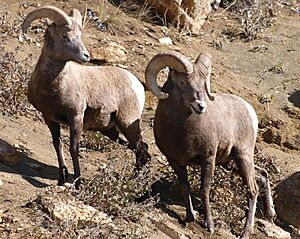
Bovids are hoofed mammals with unbranched horns. Their horns are permanent and do not shed. This group includes some of Colorado's most iconic animals. Order: Artiodactyla Family: Bovidae
- American bison, Bison bison - This animal was brought back to Colorado.
- Mountain goat, Oreamnos americanus - This animal was introduced to Colorado.
- Bighorn sheep, Ovis canadensis


